

Neuroscience. Neurosciences. How does my brain work? Ilusiones ópticas que demuestran cómo vemos, Beau Lotto. La neurociencia del poder de la voluntad: glucosa, ejercicio… y ¿magia? “El hombre puede hacer lo que quiere, pero no puede querer lo que quiere”, Arthur Schopenhauer.
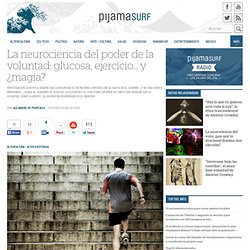
Algunas películas –quién no recuerda a Rocky Balboa levantándose de la lona y siempre reaccionando en el último round– nos han hecho ver la voluntad humana como un recurso inagotable, que entre más se usa más se manifiesta –en una especie de lucha épica con nosotros mismos. Y aunque esta visión no necesariamente esté equivocada, neurocientíficos han propuesto una teoría que sugiere que la voluntad es un recurso cerebral limitado, ligado al consumo de glucosa. En su libro Willpower: Rediscovering the Greatest Human Strength, coescrito con John Tiernet, el psicólogo Roy Baumeister plantea que la voluntad se alimenta de un suministro limitado de químicos que se acumulan en el cerebro: es “una forma medible de energía mental que se consume al usarla, igual a la gasolina en un auto”.
Tierney y Baumeister esbozan una teoría de la administración de la voluntad: es importante llevársela leve. Confirmando la precognición a través de la pornografía. A lo largo de la historia científica, por alguna lamentable razón, pocos son los investigadores que osan coquetear con posibilidades en torno a premisas que son, peyorativamente, consideradas en el rubro de lo paranormal.
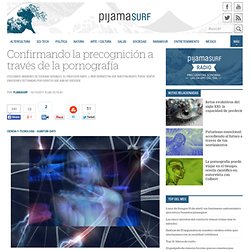
Sin embargo, además de que cada vez hay más aventureros científicos que juegan con posibilidades “extravagantes”, lo cierto es que siempre ha habido mentes lúcidas que exploran con seriedad y más allá de la charlatanería esos castigados límites del conocimiento humano. This is Your Brain in Love: Scenes from the Stanford Love Competition. El cerebro no toma decisiones a partir de la percepción en contextos de incertidumbre. 10 conferencias sobre el cerebro. Brain Rules. El cerebro inconsciente - Poder - Vìdeo Dailymotion. Recalibrate Your Reality. The Neuroscience of Decision Making. In an attempt to put matter over mind, researchers are beginning to decipher what exactly is happening in our brains when we are making decisions.

Our thoughts, though abstract and vaporous in form, are determined by the actions of specific neuronal circuits in our brains. The interdisciplinary field known as “decision neuroscience” is uncovering those circuits, thereby mapping thinking on a cellular level. Although still a young field, research in this area has exploded in the last decade, with findings suggesting it is possible to parse out the complexity of thinking into its individual components and decipher how they are integrated when we ponder. Eventually, such findings will lead to a better understanding of a wide range of mental disorders, from depression to schizophrenia, as well as explain how exactly we make the multitude of decisions that ultimately shape our destiny. The following is an edited transcript of the teleconference. C. WANG: Yes. Redes para la Ciencia » Redes 81 Los 12 pilares de la inteligencia.
La miopía de futuro - 30.06.2012 - lanacion.com. EL 15 de enero de 2009, unos pocos minutos después de despegar del aeropuerto de Nueva York, el piloto del vuelo 1549 se dio cuenta de que un problema en los motores no le permitiría llegar exitosamente a destino y tampoco volver al aeropuerto.
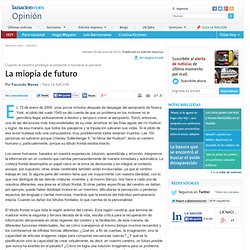
Aprender del cerebro - lanacion.com. El curso dinámico del desarrollo del cerebro resulta uno de los aspectos más fascinantes de la condición humana ya que conjuga la genética y la interacción con el entorno.
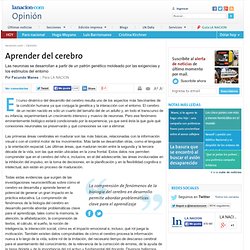
El cerebro de un recién nacido es sólo un cuarto del tamaño del de un adulto y, en todo el transcurso de su infancia, experimentará un crecimiento intensivo y masivo de neuronas. The Neurobiology of Conscious Intent. Perhaps the seminal component of any clinician’s behavioral repertoire is the ability to understand the conscious motivations and intentions of their clients.
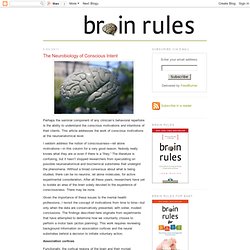
This article addresses the work of conscious motivations at the neuroanatomical level. I seldom address the notion of consciousness—let alone motivations—in this column for a very good reason. Nobody really knows what they are or even if there is a “they.” SLOMAN - PRESENTATIONS. PAST, RECENT AND PENDING PRESENTATIONS By Aaron SlomanSchool of Computer Science The University of Birmingham, UK.

This is These are presentations on topics arising in the Birmingham Cognition and Affect Project and in the Birmingham Cosy Project, including: consciousness, emotions and other affective states and processes, reasoning, evolution (trajectories in design space and niche space), information-processing, artificial intelligence, cognitive science, biology, physics, philosophy of mind, supervenience, philosophy of mathematics, epistemology, virtual machines, implementation, vision and other forms of perception -- especially visual perception of affordances, architectures for intelligent systems, forms of representation, software tools for exploring architectures and designing intelligent agents, and to some extent also about neuroscience and psychology. Note added 25 Sep 2010: I have decided to try to add some more structure to this list. Google Scholar publications list, Read online -ISBNLIB-Book infomation,Prices,excerpt,ebook download.
Formal Bayesian Theory of Surprise Home Page. For a good summary of the story which does not require any maths background, have a look at two press releases by Eric Mankin here and here.

We propose that surprise is a general, information-theoretic concept, which can be derived from first principles and formalized analytically across spatio-temporal scales, sensory modalities, and, more generally, data types and data sources. Two elements are essential for a principled definition of surprise. Percepcion: Teoria y Leyes. Steven Pinker - La tabla rasa. Grand Challenge 5: Brain and Mind. Neuromarca, el blog sobre neuromarketing. Books about the brain, brain anatomy, evolution, and the neurobiology of human behavior are profiled. Las redes sociales crearán la conciencia universal – (Entrevista a Susan Grienfield, neurocientífica, La Vanguardia, 03/07/2011) Tengo 61 años: la edad te hace más tú misma, pero sigo abierta a todo.
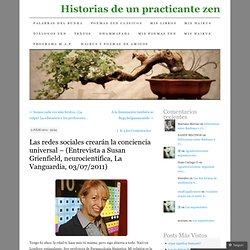
Nací en Londres: estimulante. Soy profesora de Farmacología Sináptica. Mi religión es la apertura de mente. Si no curamos el alzheimer, nuestro Estado de bienestar será insostenible. Colaboro con HSM. Quién es mejor, Mozart o Shakespeare? Si me permite, baronesa, es una pregunta estúpida. ¡Correcto! Porque el talento no se puede medir cuantitativamente. Como si fueran pichichis de la Liga… Porque lo que les hace genios no es su cantidad de genio, sino que el suyo era único e irrepetible. Midamos el esfuerzo y premiémoslo, pero no el talento. Algo que aprendes, pero no te enseñan. Incentivemos, pues, la diversidad de talentos, el genio individual de cada uno.
¿El mediocre no lastra al brillante? No hay estudiantes mediocres, sino personas que aún no han encontrado su talento: ayudémoslos a encontrarse ¡Demonios! Me parece usted muy inteligente. Intento ser yo misma. Redwood Center for Theoretical Neuroscience. Institute of Noetic Sciences. El cerebro, teatro de las emociones. Antonio Damasio, neurólogo, premio Príncipe de Asturias El estudio de las emociones desde el punto de vista de las neurociencias es un campo relativamente novedoso.

Antonio Damasio es uno de los pioneros en este tipo de investigaciones y una de las personas con más autoridad en el mundo para hablar sobre el tema. En esta charla con Eduard Punset, aborda desde la fisiología neuronal de las emociones hasta las consecuencias de ello para la educación. Fecha de la entrevista: 2006-04-11Lugar de la entrevista: Madrid Web personal de Damasio en la Universidad de Southern California.Información sobre Damasio en la web de la Fundación Premios Príncipe de Asturias.Entrada sobre Damasio en la Wikipedia (castellano, inglés, portugués).
Eduard Punset: Dices que los sentimientos son esquivos, pero también que las emociones preceden a los sentimientos. Antonio Damasio: ¡Es cierto! EP: En las escuelas, en las instituciones o en un estadio de fútbol, a veces podemos encontrar racismo. EP: Claro… How Friends Ruin Memory: The Social Conformity Effect. Humans are storytelling machines. We don’t passively perceive the world – we tell stories about it, translating the helter-skelter of events into tidy narratives. This is often a helpful habit, helping us make sense of mistakes, consider counterfactuals and extract a sense of meaning from the randomness of life. But our love of stories comes with a serious side-effect: like all good narrators, we tend to forsake the facts when they interfere with the plot. The Psychology of Nakedness. Editor’s Note: Portions of this story in italics below were found to come from LiveScience.
The human mind sees minds everywhere. Show us a collection of bouncing balls and we hallucinate agency; a glance at a stuffed animal and we endow it with a mood; I’m convinced Siri doesn’t like me. MindPapers: Contents. Search tips There are two kinds of search you can perform on MindPapers: All fields This mode searches for entries containing the entered words in their title, author, date, comment field, or in any of many other fields showing on MindPapers pages. History of Neuroscience: Gunther Stent. How neurons work. What Is the Fundamental Nature of Consciousness? [Excerpt] This chapter from PHI: A Voyage from the Brain to the Soul, by Giulio Tononi (Pantheon, 2012) describes Tononi’s theory of consciousness as a measure of information. The brain, Tononi postulates, consists of billions of neurons: think of them as if they were transistorlike bits that, when tallied, sum to equal more than their parts.
That increment above and beyond—Tononi calls it phi—represents the degree to which any being, whether human or mule, remains conscious. From the forthcoming book PHI: A Voyage from the Brain to the Soul, by Giulio Tononi Copyright © 2012 by Giulio Tononi. History of Neuroscience: Torsten Wiesel. Pavlov (1927) Explore the Brain and Mind - BrainFacts.org. Oxford Foundation for Theoretical Neuroscience and Artificial Intelligence.
Neuromarketing. Try It Yourself. Eye Movements Do Not Reveal Lying: Scientific American Podcast. The eyes are the windows to the soul. As such they can reveal if someone is lying, right? Cop shows, advice shows, even some organizational training courses hold that if somebody looks up and to the right, they’re probably lying. Up and to the left means they’re telling the truth. Now a study says that there is no connection between eye movement and lying. Your Brain on a Magic Trick. What Happens to Consciousness When We Die. Where is the experience of red in your brain? The question was put to me by Deepak Chopra at his Sages and Scientists Symposium in Carlsbad, Calif., on March 3. A posse of presenters argued that the lack of a complete theory by neuroscientists regarding how neural activity translates into conscious experiences (such as redness) means that a physicalist approach is inadequate or wrong.
The idea that subjective experience is a result of electrochemical activity remains a hypothesis, Chopra elaborated in an e-mail. It is as much of a speculation as the idea that consciousness is fundamental and that it causes brain activity and creates the properties and objects of the material world. Where is Aunt Millie's mind when her brain dies of Alzheimer's? David Eagleman: The human brain runs on conflict. This article was taken from the May 2011 issue of Wired magazine. Be the first to read Wired's articles in print before they're posted online, and get your hands on loads of additional content by subscribing online. Throughout the 60s, pioneers in artificial intelligence worked late nights trying to build simple robotic programs capable of finding, fetching and stacking small wooden blocks in patterns.
It was one of those apparently simple problems that turn out to be exceptionally difficult, and it led AI scientists to think: perhaps the robot could solve the problem by distributing the work among specialised subagents -- small computer programs that each bite off a piece of the problem. Unlocking the Secrets and Powers of the Brain. Zimmer: There is a lot of work lately in understanding how perception translates into action, making sense of what goes on when we make a decision to do something.
Wang: Some neuroscientists who are studying these processes are interested in the idea that perhaps you could have a brain center that gathers evidence and reaches a threshold for making a commitment. There might be another brain center that expresses confidence in the decision or even the very awareness of the decision. Here’s an example that many of you may have encountered from everyday life. You may be presented with a dilemma—say, whether to take a job in a new city.
The pioneering psychologist Amos Tversky once did an informal survey over a period of years, asking people how confident they were that they were going to take such a job offer. So you can be pretty committed to a decision yet be unaware of it. The Amygdala Made Me Do It. It’s the invasion of the Can’t-Help-Yourself books.
Unlike most pop self-help books, these are about life as we know it — the one you can change, but only a little, and with a ton of work. Professor Kahneman, who won the Nobel Prize in economic science a decade ago, has synthesized a lifetime’s research in neurobiology, economics and psychology. “Thinking, Fast and Slow” goes to the heart of the matter: How aware are we of the invisible forces of brain chemistry, social cues and temperament that determine how we think and act?